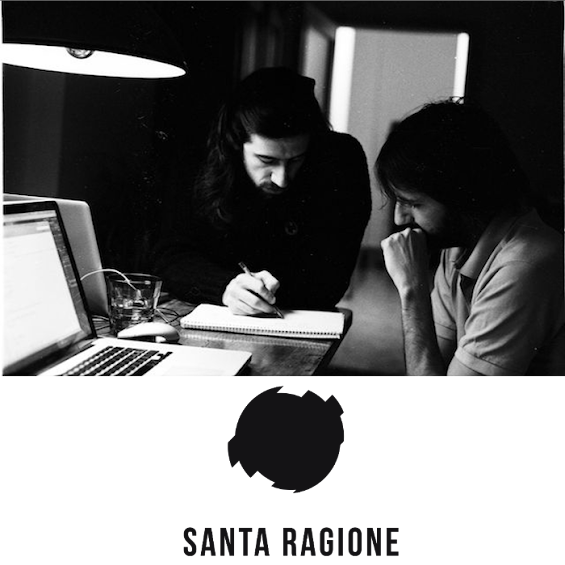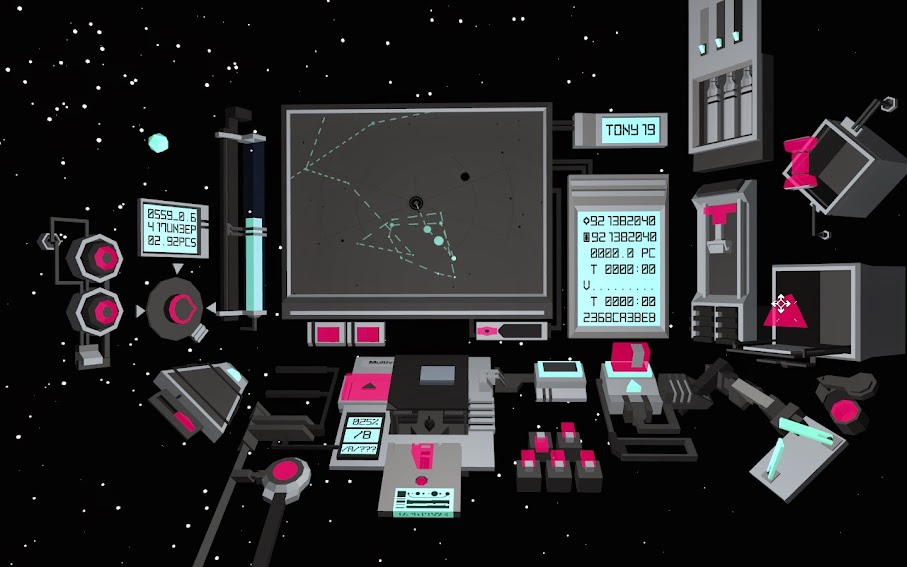Of Moons and (Sprinting) Men - A Retrospective Interview with Santa Ragione
With Mirrormoon EP being a full year behind us, and their next big title just weeks away, I chat with the devs from Santa Ragione about game design and their interesting job as indies.


___________
Last year, dozens of games were honored at the Independent Game Conference. MirrorMoon EP was one of those games.
The flagship title of Indie developer Santa Ragione has mustered praise from critics and commoners alike (but you yourself know that in the gaming world, even us "commoners" have a strong voice).
 One year ago, MirrorMoon dawned virtual shelves. And in less than two weeks, the guys behind the game debut their next big thing to the world: FOTONICA, a fast-paced action thriller centered on good feel and classic gameplay. So it only stands to reason that this may be a very important time for Santa Ragione.
One year ago, MirrorMoon dawned virtual shelves. And in less than two weeks, the guys behind the game debut their next big thing to the world: FOTONICA, a fast-paced action thriller centered on good feel and classic gameplay. So it only stands to reason that this may be a very important time for Santa Ragione.
After requesting an interview with the crew, they happily obliged! You'll glean something special from their words, whether you're an indie, a MirrorMoon fan, or even an extraterrestial. We talk design and the future, and somehow we managed to include a bit about italian coffee-cake. No kidding.
_____________________________________________________
Darius (Me): I want to get to know you as individuals. So let’s get personal. Take off your Indie hats for a moment, and tell us a little (or a lot) about yourselves.
Paolo (PA): I live alone in a small apartment. There’s a beautiful double bass near my desk, that is also the table where I eat. Sometimes I move in for some days with these other two guys, and we work and play games together. I love craft beers. I’m trying to spend less time on Facebook. I’m playing Desert Golfing at the moment.

Pietro (PIE): I finished my studies this year. I defended my doctorate thesis on how to design games that are not objective-driven in March. After that, I mainly worked on FOTONICA iOS
and PC. It feels like I haven’t done much that was unrelated to games recently! I am traveling to Istanbul next month -- it’s my favorite city in the world, so that’s very exciting.
Nicolò (N): I’m currently spending my time between Milan, where I live with Pietro, and Verona where I used to live and where most of my old friends still are. I like to draw when I can and tinker with electronics when I’m feeling brave enough to do so. I’m interested in philosophy, art (especially modern and contemporary), and music. Big Frank Zappa fan.
Wow, Pieto and Nicolo, you've got quite the adventure! As for you Paolo, we mourn with you as you are chained to a desk in your small apartment. Congratulations on your studies, Pietro.
Are you just normal guys who eat wheaties for breakfast and like college football, or is there something special that we should know about what contributes to your success?
PA: Well, I’ve been making games for more than 15 years, always small projects, but you can call it a bit of experience. It helps you mostly to avoid bad, large, mistakes. I keep making the small ones, though.
PIE: We don’t have college football in Italy. We have soccer, but the only really followed league is Serie A. The three of us are not very much into soccer really. If I had to point at something that contributes to our “success”, it is that we have formal educations in non-game related fields. I have been studying Design for 9 years, and Nicolò has a traditional artist background. All three of us also love to spend an afternoon visiting a contemporary art exhibition, and I feel that gives us an edge too.
N: What Pietro said is right. If there is something that contributed, it is probably our education. The humanistic studies we followed are part of our ability to look at things a bit differently.
The aesthetic styles which your games express bear witness to your "cultured" and diversly educated background. History is a paintbrush in the hand of the artist.
So What is it that fuels your passion to make great games?
PA: The possibility to make something new, to explore new mechanics. the fact that I can work with friends  and avoid the pitfalls of the common work environment.
and avoid the pitfalls of the common work environment.
PIE: The absolute conviction that games could be so much more than what they are right now.
N: Playing has always been a social activity to me. A dialogue of some sort. Games to me are shared experiences and I play because it’s a way to relate to people. Sometimes a way to relate to new and unknown objects, as well.
Superb answers. I resonate strongly with you, Pietro. Our medium is still a baby in its growing stages, and it takes someone with vision to see the branching possibilities.
Well here we are, a year after the release of your raved-over title, MirrorMoon EP. What are your thoughts about the game now compared to what they were when it released?
PA: I’m very happy with the critical reception of the game, and also the commercial reception, whichsomehow has allowed me to be indie for one year.
PIE: Nicolò is mostly responsible for the art direction so I think I can answer this without false modesty. When I look at the game, particularly at the screenshot section on the Steam community pages, I am so happy about how GOOD the game looks. I am glad we made it, I am glad we made it in a short amount of time, and I am surprised by how well it was received by players. Some people have played hundreds of hours, which is way beyond the scope of the game we made.
N: It is still kind of surprising to see so many people enjoying the game.
Because the game's alluring atmosphere promises so much, players have dared to spend many hours looking for what could be out there. That' a mark of great design.
Even so, I know there are things you would have changed given the extra time. What is something you really wished you would have put more time and effort into?
N: To have a couple of more planets with authored puzzles, similar to the very first one, within all the generated ones would have helped the flow of the game.
PIE: Everything and nothing. I am really happy about how we balanced our ambition and our resources for MMEP. I think every single aspect of the game could have been improved, but that can always be said, especially from an author’s perspective. If I had to pick something, though, I wish we had a bigger, more developed ending to the game. Then again, only 2% of players really completed MirrorMoon EP.
PA: I would have liked to put more variety in puzzles. They sometimes surprise me even now, but with the addition of a couple of mechanics, they could have been much less repetitive.
As a matter of fact, 90% of players that begin any given game never even finish.* And Nicolò, if a game can surprise you at all after playtesting for 1200 hours, you know you've got something. :^D
Let's look at the flip-side. I’m sure there was at least one spectacular feature that you were going to add to MirrorMoon EP, but decided not to. What was it, and why did you leave it out? Do you think we’ll see that feature rebirthed in a future game?
PA: VR? I would like to see that.
PIE: Yeah, it always goes like that. There are many features in MMEP itself that come from previous canceled projects, or concepts that were never produced. At the same time, there are ideas we wanted for MMEP that didn’t make it into the finished game. One of them is the ability to leave complex messages for other players that would integrate with the game narrative.
Really, I'd like to hear what fans think of the message feature.
You all can testify that game development isn’t easy, but it’s worth it. Take us to a time when you came very close to throwing in the towel on the MirrorMoon EP project.
PA: The project was on halt until we were nominated for the IGF Nuovo Award. Then we knew something had to be done.
PIE: There were a few of these moments. At some point, we completely re-designed and re-engineered the way the procedural puzzles were generated on the planets. This put a ton of pressure and a considerable workload on Paolo, who had to implement it. This happened right at the end of crunch, after we released the beta. I was worried Paolo wouldn’t have made it, but he did a great job, and the final result I think is better than what we hoped it would be.
The 2013 Nuovo nomination (that's a monetary prize awarded to 'honor abstract... and unconventional game development') would definitely be a wake up call. To give you readers a backdrop, Little Inferno; FTL: Faster Than Light; Kentucky Route Zero; and Guacamelee were also finalists of their respective categories that same year.*
What was that one pivotal point that set the course for MirrorMoon to be the winning game that players cherished?
 PIE: In particular, I remember a phone call I made to Nicolò while I was waiting on a Yellow Line subway track in Milan. I had the idea of binding the two (at the time) scenes of MirrorMoon via a physical interface, that would have a physical floppy disc flip around to represent the loading of the scenes. From there, we started discussing the idea of integrating the whole menu in a physical way. This is the thought that eventually spawned the concept of a navigation scene, and the idea of physically travelling between planets.
PIE: In particular, I remember a phone call I made to Nicolò while I was waiting on a Yellow Line subway track in Milan. I had the idea of binding the two (at the time) scenes of MirrorMoon via a physical interface, that would have a physical floppy disc flip around to represent the loading of the scenes. From there, we started discussing the idea of integrating the whole menu in a physical way. This is the thought that eventually spawned the concept of a navigation scene, and the idea of physically travelling between planets.

The spacecraft's "touchable" control panel
Intruiging. What you accomplished there is what I call deinstitutionalization. It's when you replace meters, numbers, and stats with something real and palpable...like a floppy disc! (I take that back, floppy discs are science fiction).
Anyway, I want to now ask a similar question: what was your greatest “aha” moment in the process of creating MirrorMoon EP?
PA: The brainstorming of the first version of the game, was a fast sequence of “aha” moments. When you understand what the first assumption (“the moon is the map”) brings in gameplay terms, how the powers interacts… your head explodes. :D That is also the usual reaction players have while playing the first part of SIDE A.
PIE: I agree that the only part of development that felt like that was the initial concept. Everything else was very deliberate and, frankly, difficult design choices aimed at transforming the initial prototype into an actual game while preserving our vision of what the game should have been about.
In making my own game right now, most of the bright ideas were indeed birthed in the planning stage. Is there a hidden aspect of MirrorMoon EP that contributes greatly to its fun that the untrained eye misses…perhaps that only the devs would recognize?
PIE: I think the thing that is closest to this definition is how we balanced nothingness in the universe with respect to actual discoveries. It’s by no means a problem we fully solved, but it is something that is completely hidden, and yet crucial for how the game is supposed to work. One complaint we get from time to time is how there are a lot of planets that are completely empty (actually fewer than 15%, if I’m not mistaken). In reality, that is a very small number compared to  everything else that players can discover in the universe (and the number of actual empty planets in the real world), and it is the absolute minimum we could go with to give meaning to the discoveries. In other words, to make discovering the artifacts and the architecture exciting, we had to make them rare occurrences. For this reason we have a whole system that manages rarity in MirrorMoon EP and distributes entities in the galaxy.
everything else that players can discover in the universe (and the number of actual empty planets in the real world), and it is the absolute minimum we could go with to give meaning to the discoveries. In other words, to make discovering the artifacts and the architecture exciting, we had to make them rare occurrences. For this reason we have a whole system that manages rarity in MirrorMoon EP and distributes entities in the galaxy.
Most players get a general sense of this sparsity beforehand, because the screenshots and videos project this. That just means you attract the right audience.
Okay, we're going to switch gears here. You’ve got a new project releasing soon dubbed FOTONICA. Tell us about that.
 PIE: FOTONICA is a first person game about running and jumping. This is the super simple premise, and on top of that, we built what we believe is a very exhilarating aesthetic experience that incorporates the tradition of arcade games in what is basically an exploration game. FOTONICA is a game of reflexes, but is just as much about discovering the most efficient path, and how to reach it, by modulating your speed and your jumps.
PIE: FOTONICA is a first person game about running and jumping. This is the super simple premise, and on top of that, we built what we believe is a very exhilarating aesthetic experience that incorporates the tradition of arcade games in what is basically an exploration game. FOTONICA is a game of reflexes, but is just as much about discovering the most efficient path, and how to reach it, by modulating your speed and your jumps.
That sounds fun and I'm not just saying that for the interview's sake! More than anything else, what do you want to see out of this new game?
PIE: It’s a gamey game, so my ambition is primarily that people enjoy it and have a visceral, non-intellectual reaction to it. I hope the visuals and audio are a treat to players. For us it was all about delivering that sensation of speed and vertigo, and when we see FOTONICA players physically leaning forward, in the real world, well that’s very satisfying. It’s also worth pointing out that FOTONICA was our first digital commercial project. We initially released it in a much smaller version in 2011, which we recently expanded and polished for release on iOS. We are re-launching on Steam this coming November the 6th, with what we might call a “definitive” version. I hope the amount of work that went into making this latest version as rich and polished as possible will be obvious.
Thank you for your time; your words have given me insight. Reader, hopefully you feel the same. Now let’s step back and look at your desires for game development as a whole. What is your dream for the games you create? When all is said and done in life, what do you want them to accomplish?
PIE: I like to think of working on games as an ongoing process, not something that survives me as a legacy. Ideally, I would want to be part of something. I would want to contribute to the creation of a new language for games, one that can be inclusive, that can be mature, that can be personal and culturally challenging. I would like for my games to be looked upon as meaningful. I would want them to say something about me, about my beliefs, and possibly about my history and my culture.
PA: I would like my games to surprise people, to show them something they have never thought of, to expand their mind.
Remove all the perceived technological, economic, and physical limits of video games. Now, game maker, what would you do with that?
N: Probably nothing. Limitless is no fun. Limits are what makes this type of work, if not any possible type of work, interesting and challenging. To understand a medium is to understand its limits, its boundaries and use them to your advantage.
PIE: What Nicolò said. Any artist works with (often self-imposed) technological limitations, that are conversely part of the artwork in an expressive way. I believe that a powerful design is one that is not constrained by limitations, but enriched by them. To answer the question more directly, I think that not having any financial limitation, i.e. not being concerned with sales, would enable us to be way more experimental. As far as creative limitations go, I would have to say that approaching accessibility and inclusivity, and understanding how they can enrich or limit a design, is the toughest of all.
Very good answers. I had not considered it from that angle. Now for one last very hard question: If your codesigners were food, what food item would they be?
PA: Tiramisù
PIE: There is a pizza at our favorite Sardinian pizza place called Arbatax. Probably that.
N: Can’t answer, I’m on a diet right now.
Okay, readers, you can take that as you will! If you're like me, you'll have to Google "Tiramisu" (that's where the cake comes in).
Thanks so much, Pietro, Paolo, and Nicolò! This has been quite a pleasure. You can discover MirrorMoon EP right now on Steam and experience the game yourself. And don't forget to check out Fotonica, which is due to stock Steam store shelves in just a few short weeks.
Keep reading and keep looking, developers. There's more to be attained.
_________________________________________________________________________
Follow my game @amoebaoflight
*Taken from Kotaku.com, "Nine Out of Ten Will Not Finish the Game They Are Playing". Original quote from CNN.
*The Independent Gaming Festival (IGF) is a yearly event that was "established in...1998 to encourage innovation in game development and to recognize the best independent game developers." (taken from www.igf.com, Copyright © 2014 UBM Tech, All rights reserved)
*IMG CREDITS: 1- Manhoff on Steam, 2 - A Victim Of Stars on Steam, 3 - TK_Tony on Steam
Photographs of the team and the Santa Ragione Logo are (C) Santa Ragione 2010-2013
Read more about:
BlogsAbout the Author(s)
You May Also Like







.jpeg?width=700&auto=webp&quality=80&disable=upscale)








